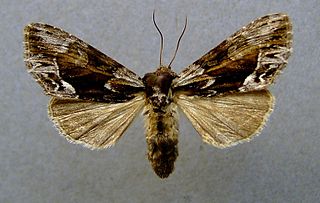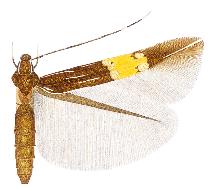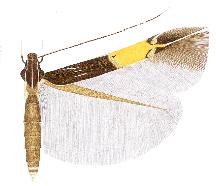
Macroglossum divergens, the broad-bordered hummingbird hawkmoth, is a moth of the family Sphingidae. It was described by Jean Baptiste Boisduval in 1875. It is found from north-eastern Sikkim, India across southern China to Cheju Island, southern Japan, Taiwan and the Philippines and then south through Vietnam, Thailand, Malaysia and Indonesia to New Guinea and neighbouring islands. It may be in Sri Lanka.

Hyppa rectilinea, the Saxon, is a moth of the family Noctuidae. It is found in Europe, but mostly in northern and central Europe. In the south, it is found in scattered populations, mainly in mountainous areas. To the east, its range stretches through northern Asia and eastern Siberia, up to the Pacific Ocean and Japan.

Oxyptilus parvidactyla, also known as the small plume, is a moth of the family Pterophoridae found in Africa, Asia and Europe. It was first described by Adrian Hardy Haworth in 1811.

Capperia britanniodactylus, also known as the wood sage plume is a moth of the family Pterophoridae, found in Europe. It was first described by Charles Stuart Gregson in 1869.

Cosmopterix astrapias is a moth of the family Cosmopterigidae. It is known from the United States, Argentina, Costa Rica, Jamaica, Mexico (Tabasco) and Puerto Rico.

Cosmopterix scirpicola is a moth of the family Cosmopterigidae. It is known from the United States, where found from Maryland and eastern Wyoming to Florida, south-western Louisiana and California. It has also been recorded from Alabama.

Cosmopterix teligera is a moth of the family Cosmopterigidae. It is known from the United States, Brazil, Colombia, Costa Rica, Cuba, Jamaica and Mexico (Tamaulipas).

Ichneutica pelanodes is a moth of the family Noctuidae. It is endemic to New Zealand and has been found in scattered locations in the North, South and Stewart Islands. I. pelanodes is easily confused with I. skelloni as the two species are visually extremely similar. In the North Island though the range of the two species appears not to overlap. Generally of the two species I. pelanodes tends to be darker in appearance. I. pelanodes inhabits wetlands but the life history of this species is unknown as are the host species of its larvae. Adults are on the wing from October to February and are attracted both to sugar and light traps.

Mniotype adusta, the dark brocade, is a moth of the family Noctuidae. It was described by Eugenius Johann Christoph Esper in 1790. It is found throughout much of the Palearctic from Europe to Japan, China and Mongolia. It is also found in North America. The habitat consists of heathland, chalky downland, fenland, moorland and upland areas.
Apachea barberella is a moth in the family Depressariidae, and the only species in the genus Apachea. It was described by August Busck in 1902. It is found in North America, where it has been recorded from Montana, Colorado, New Mexico, Arizona, Utah and California.
Gnorimoschema batanella is a moth in the family Gelechiidae. It was described by August Busck in 1903. It is found in North America, where it has been recorded from California, Illinois, Kentucky, Maine, New Jersey and Ontario.
Gnorimoschema dudiella is a moth in the family Gelechiidae. It was described by August Busck in 1903. It is found in North America, where it has been recorded from Arizona and Texas.
Gnorimoschema florella is a moth in the family Gelechiidae. It was described by August Busck in 1903. It is found in North America, where it has been recorded from Colorado and California.
Gnorimoschema semicyclionella is a moth in the family Gelechiidae. It was described by August Busck in 1903. It is found in North America, where it has been recorded from Colorado, Oregon, Wyoming and New Mexico.
Gnorimoschema coquillettella is a moth in the family Gelechiidae. It was described by August Busck in 1902. It is found in North America, where it has been recorded from California and Colorado.
Gnorimoschema gibsoniella is a moth in the family Gelechiidae. It was described by August Busck in 1915. It is found in North America, where it has been recorded from Alberta, Manitoba and Illinois.
Gnorimoschema terracottella is a moth in the family Gelechiidae. It was described by August Busck in 1900. It is found in North America, where it has been recorded from Florida and Alabama.
Gnorimoschema serratipalpella is a moth in the family Gelechiidae. It was described by Vactor Tousey Chambers in 1877. It is found in North America, where it has been recorded from Colorado and New Mexico.
Gnorimoschema ericameriae is a moth in the family Gelechiidae. It was described by Keifer in 1933. It is found in North America, where it has been recorded from California.
Scrobipalpula erigeronella is a moth in the family Gelechiidae. It was described by Annette Frances Braun in 1921. It is found in North America, where it has been recorded from Montana.





